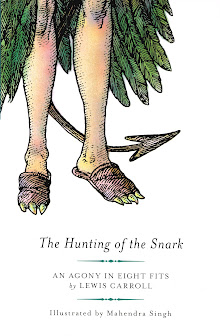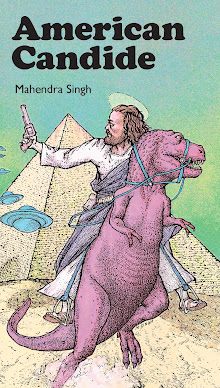Instead of the usual Snark blather, I think that a process post would make a nice change. I recently did 17 illustrations for Forrest Leo's novel,
The Gentleman, just published by Penguin/RandomHouse, and here's a look at a full-page I did for Chapter 2.
The novel is a bit hard to classify, which is always a good thing … a multi-homage to James Cabell, P.G. Wodehouse, various steampunk illuminati and even such recondite corkers such as
The Diary of a Nobody and
Augustus Carp. Set in a slipstreamed 19th-century, the story involves the romantic intrigues of a young poet who has accidentally consigned his young bride to hell. There's lots of steam-powered ornithopters, pistol duels, satanic visitations, cool Victorian womenswear and more to my point, both the author and the editorial team (Ed Park editing, Claire Vacarro art directing) were keenly aware that James Cabell's illustrator was none other than the late, great Frank Papé.
That posed a conundrum for this illustrator. Papé tended to go for a very Symbolist handling of his material and although Forrest was certainly working the same Cabellian vein, he had wandered off in a more Victorian steampunk direction. I felt it best to emphasize the Victorian feel with a faux wood engraving style of rendering plus a more sedate Victorian style of design. Melodrama on a stage within a defined picture frame, that's the way they liked it back then. Which is where this process post kicks off: the initial thumbnail concept for a scene illustrating the young hero-poet being soundly slapped by his angry sister in the presence of their much-suffering butler.

The Victorian illustration is a theatrical picture space, ie., no funny angles or odd positioning of actors, just a 3-D volume seen head on through a normal picture plane, as if we are in the front row seats. Hence the reaher sedate composition of this thumbnail. Emotion would be concentrated in the sister's about-to-slap hand and also in the books literally flying off the shelves, The scene is set in the hero's library and that was a major theme of the novel: it was a novel about many other novels (and poems) and I wanted to emphasize this visually.
The text box at the bottom was for Claire's initial idea of running a title cartouche at the bottom of every full-pg illo, in the true Papé spirit, an idea she later dropped. In any case, the main thing was the thumbnail was clearly Victorian in feel and gave full scope for lots of Easter eggs.
I'd like to note that this thumbnail concept was probably the 4th or 5th idea I had for this picture, it's really important to not be satisfied with your first or even second idea, it's usually best to sleep on it and come up with more ideas, for several days if possible and eventually, things will work out for the best. This is the great advantage of book illustration, you have the time to think at length. And nap between thumbnails, that's always nice, plus lots of tea, that goes without saying.

After approval of thumbnail, I did a tight pencil on vellum, focussing only on outlines. Sometimes I do a value study, usually in Photoshop atop a scan of the pencil but I didn't on this picture. On reflection, that was a mistake on my part. In any case, Ed and Claire seemed happy with this pencil and as far as the values went, there was only one possible solution: a background of about 40%K, going from light to dark as the page descended to create a theatrical effect (something Gustave Doré often did to great effect) and everything else high-contrast, with shadows about 75%, a few midtones at about 25% and sufficient blown-out highlights.
This pencil was about 20, 30% larger than my final inking, which I did from a
reduced scan of the pencil. That final inking was still about 15%
larger than the final print version. My eyes are tired and my hands
arthritic, every square inch hurts. I ink on denril, a synthetic vellum, with acrylic ink, using dip nibs, on this job, Gillot 1950 for the tight lines and Brause 66EF for the heavier lines. Really tight hairlines were done with a Hunt 104. I use a floating, illuminated magnifying lens while wearing a specially prescribed pair of coke-bottle lensed glasses designed to magnify at 20 cms. I like to ink very tight and very clean. When this job was done, I had some posters made of the art for promotional purposes, the inking easily blew up to 400% while looking very crisp and optically balanced.
Using dip nibs is mandatory for serious, complex inking and any inker who thinks that they can get away with felt-tips is only kidding themselves, their inking will always lack snap and energy. The constant swell and contraction of the dip nib conveys the movement of the hand and wrist, which is the essence of good inking. I also avoid using scratchboard for the same reason, the scraper blades cannot flex, giving the line work a mechanical feel. Sometimes that's necessary but frankly, I loathe it. As for digital inking … my opinion of it is unprintable.

Here's the initial inking. I had deleted the snakes with my electric eraser (another advantage of using Denril, it's easy to erase and re-ink), they simply weren't working. In fact, the entire drawing was not making me too happy, it lacked energy. The slap in the face was lost in a maelstrom of lines and shapes. It was time for a painful re-evaluation of the situation. Also, half-way through the inking, Ed and Claire realized that my rendition of the sister's face was not quite right for the text. I was making her too tarty and too old … ah, middle age, when all romantic hullaballo is but a sound and fury signifying nothing.
But they were right, she wasn't quite on the mark. Every book you illustrate involves a drift away from the text towards your own ideas on the same material, and sometimes that drift works and sometimes it doesn't. In any case, this picture was a problem child (the fact that it was the first picture I inked was part of the problem, you tend to warm up conceptually and physically as you go along).
And so, dear reader, I cropped it. Thank the gods of obsessive inking that I had the extra space and size to make it work in the trim size. I also inked a new head, can't remember if I did it on this drawing or a separate piece of Denril, but in any case, here it is: A Slap in the Face, Redux.

The butler gone, the serpents vanished, the sister had a face-lift and I had tossed away several painful hours of inking (I estimate about 24 man-hours for the whole page) but now things were pulling together. I had sacrificed the faux Victorian feel for a more modern crop but it had salvaged the picture's story and that is the bottom line in illustration: every line you draw must have a genuine function. It must advance the story and also serve a necessary structural purpose. Inking to fill space is a heinous affront to the gods of freelance, they like your pages to work hard for the money. The more you put into the page, the more it gives back to the reader and that makes for happy readers and happy editors. When everybody is selling less for more, such strategies pay off handsomely.
To sum up for the jury, every line must have a purpose and every white space also. The primary purpose is narrative, the secondary is optical pleasure, which is the same thing but on a more visceral level. Never hesitate to spend extra time on a picture, no matter the client. Do a lot of thumbnails, pencil thoroughly to cover all inking contingencies and no matter your inking style, take the time to make it look the best you humanly can at that moment in your development.
On a final but inevitable mercenary note, if anyone wishes to purchase some of the original art for this book, drop me a line … mahendra373 at hotmail dot com. Support the arts by supporting my need to nap and drink tea between inking bouts! Aye, work is the curse of the inking classes.










































